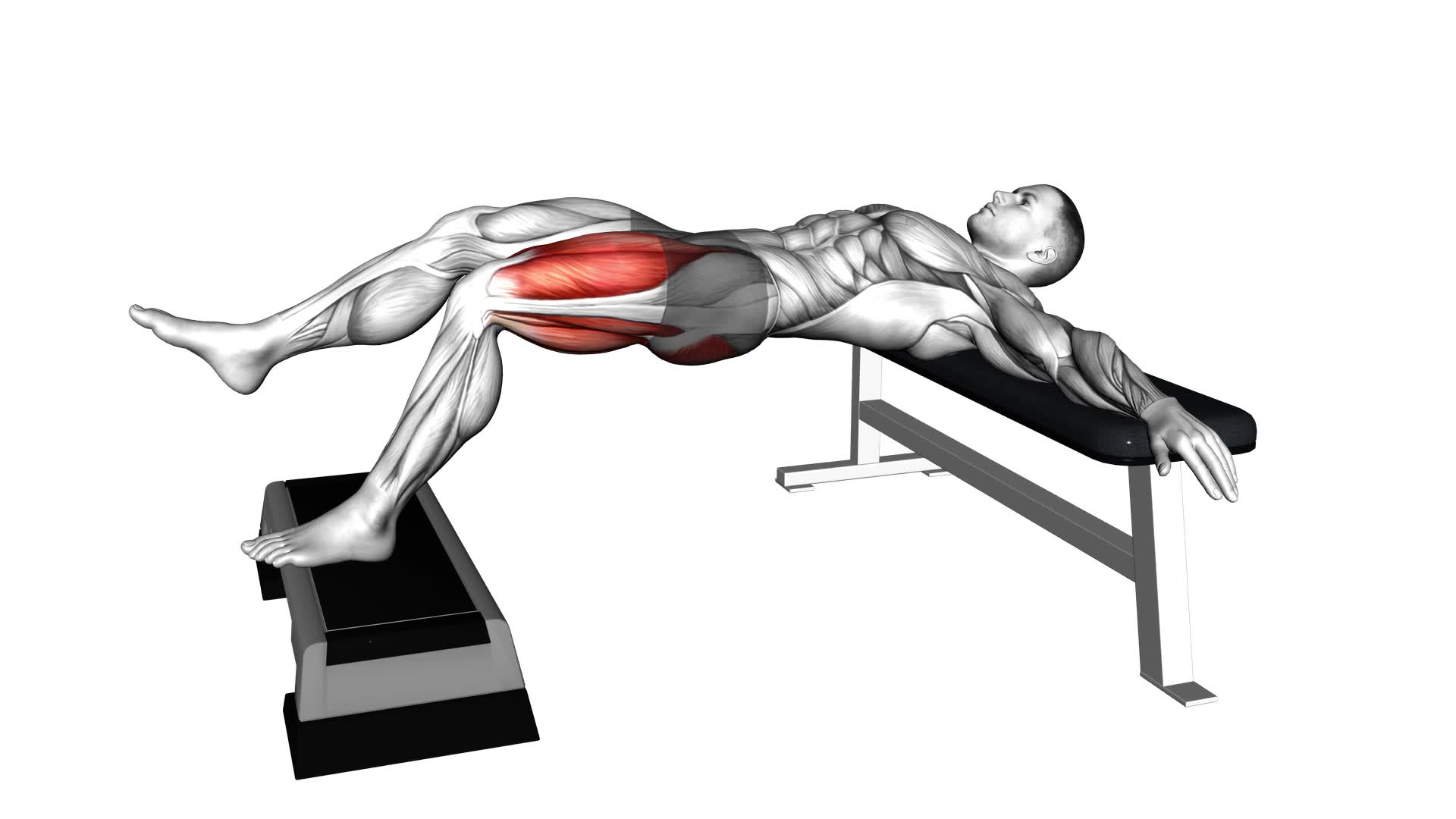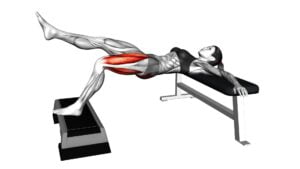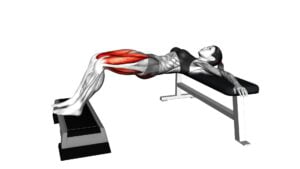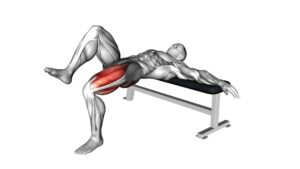Elevated Single Leg Hip Thrust (male) – Video Exercise Guide & Tips

Looking to improve your lower body strength and build a stronger booty? The elevated single leg hip thrust is the perfect exercise for you.
Watch This Exercise Video
This video exercise guide and tips will show you the proper form and technique to get the most out of this challenging move.
Learn about common mistakes to avoid, variations and modifications to try, and get expert advice on maximizing your results.
Get ready to feel the burn and sculpt your glutes with this effective exercise.
Key Takeaways
- Improves glute strength
- Prevents lower back pain
- Enhances lower body strength and stability
- Suitable for all fitness levels
Benefits of the Elevated Single Leg Hip Thrust
Discover the benefits you can gain from incorporating the Elevated Single Leg Hip Thrust into your workout routine.
This exercise is highly effective in improving glute strength and preventing lower back pain. By specifically targeting the glute muscles, the Elevated Single Leg Hip Thrust helps to strengthen and tone these important muscles. Strong glutes not only enhance the appearance of your buttocks but also improve overall lower body strength and stability.
Additionally, this exercise can help prevent lower back pain by strengthening the muscles surrounding the lumbar spine. The glutes play a crucial role in supporting the lower back, and by strengthening them, you can alleviate stress on the lower back and reduce the risk of injury.
Incorporating the Elevated Single Leg Hip Thrust into your workout routine can also improve your athletic performance. Strong glutes are essential for activities such as running, jumping, and squatting, as they provide power and stability.
Moreover, this exercise can be easily modified to increase or decrease the intensity, making it suitable for individuals of all fitness levels.
Start incorporating the Elevated Single Leg Hip Thrust into your workouts today to experience the numerous benefits it offers.
Proper Form and Technique
To perform the Elevated Single Leg Hip Thrust with proper form and technique, position yourself on the elevated platform with one foot planted firmly on the ground. Here are some common cues to help you execute this exercise correctly:
- Start by lying on your back with your shoulders and head resting on the ground and your other leg extended straight out in front of you.
- Place your arms out to the sides for stability and support.
- Engage your glutes and core as you lift your hips off the ground, driving through the heel of your planted foot.
- Keep your elevated leg straight and avoid letting it drop or wobble during the movement.
To ensure you're performing the Elevated Single Leg Hip Thrust safely and effectively, consider these potential modifications:
- If you're new to this exercise, begin by practicing the movement without using an elevated platform.
- Use a lower platform or step to decrease the range of motion if you experience any discomfort or limitations.
- If you struggle with balance, place your hands on the sides of the platform for additional support.
- If you're looking to increase the intensity, hold a weight or resistance band across your hips.
Common Mistakes to Avoid
Now let's address some common mistakes to avoid when performing the Elevated Single Leg Hip Thrust.
Proper alignment is key to getting the most out of this exercise and preventing injury. One common mistake is allowing your knee to cave in or out during the movement. To avoid this, focus on keeping your knee in line with your hip and ankle throughout the entire exercise.
Another mistake is lifting your hips too high or not high enough. Aim for a straight line from your knee to your shoulder at the top of the movement. It's important to engage your glutes and avoid relying solely on your lower back muscles.
Keep your core tight and squeeze your glutes at the top of the movement for maximum effectiveness. Lastly, don't rush through the exercise. Take your time and focus on maintaining proper form and alignment.
By avoiding these common mistakes, you'll be able to perform the Elevated Single Leg Hip Thrust with proper technique and get the most out of your workout.
Now let's move on to the next section to discuss variations and modifications.
Variations and Modifications
Try incorporating different variations and modifications into your Elevated Single Leg Hip Thrust routine to target different muscle groups and make your workouts more challenging. Here are some advanced variations and injury modifications to consider:
- Advanced Variations:
- Weighted Single Leg Hip Thrust: Hold a dumbbell or a barbell across your hips to add resistance and increase the intensity of the exercise.
- Single Leg Hip Thrust with Leg Extension: At the top of the hip thrust, extend your elevated leg straight out in front of you, engaging your glutes and hamstrings even more.
- Single Leg Hip Thrust with Abduction: As you lift your hips, simultaneously move your elevated leg out to the side, targeting your glute medius and outer hip muscles.
- Injury Modifications:
- Bilateral Hip Thrust: If you have an injury or discomfort in one leg, perform the exercise with both feet on the ground to distribute the load evenly.
- Glute Bridge: If the hip thrust is too challenging or causes pain, start with a glute bridge, where both feet are on the ground, and gradually progress to the single leg version.
Remember to always listen to your body and modify the exercise as needed to prevent any further injuries or discomfort.
Tips for Maximizing Results
Focus on proper form and technique to optimize your results. When performing the elevated single leg hip thrust, it's crucial to maintain the correct posture throughout the exercise. Keep your core engaged, maintain a neutral spine, and avoid excessive arching of your back. This will ensure that you're targeting the correct muscles and maximizing the intensity of the exercise.
Incorporating resistance is another key tip for maximizing your results. As you become comfortable with the exercise, you can add additional weight to increase the challenge and stimulate muscle growth. You can do this by using a barbell placed across your hips or by holding a dumbbell or kettlebell against your pelvis. Gradually increase the weight as you get stronger to continue challenging your muscles and promoting growth.
Remember to start with a weight that's manageable and allows you to maintain proper form. It's better to use lighter weight with correct form than to use heavier weight with poor form. As you progress, focus on gradually increasing the resistance to keep pushing yourself and stimulating muscle growth.
Frequently Asked Questions
How Many Calories Does the Elevated Single Leg Hip Thrust Burn?
The elevated single leg hip thrust is a great exercise for targeting your glutes and burning calories. While the exact number of calories burned during this exercise will vary depending on factors like your weight and intensity, it's generally considered to be an effective calorie-burning exercise.
To increase the intensity and calorie burn, you can also try variations of the exercise using weights. Incorporating weights into the elevated single leg hip thrust can help you build strength and burn even more calories.
Can the Elevated Single Leg Hip Thrust Be Done With Weights?
Yes, the elevated single leg hip thrust can be done with weights. Adding weights to the exercise can increase the intensity and challenge your muscles even more. You can use a dumbbell, barbell, or even a weighted vest to perform the weighted single leg hip thrust.
This variation of the exercise targets your glutes, hamstrings, and core effectively. It's a great way to take your single leg hip thrusts to the next level and continue progressing in your workouts.
Is the Elevated Single Leg Hip Thrust Suitable for Beginners?
Yes, the elevated single leg hip thrust is suitable for beginners. It's a great exercise to strengthen your glutes and improve hip stability.
To perform it correctly, make sure to maintain proper form by keeping your core engaged and your hips level throughout the movement. Common mistakes include using momentum and not fully extending your hips at the top.
As a beginner, start with bodyweight and gradually increase the intensity by adding weights or progressing to more challenging variations.
How Often Should the Elevated Single Leg Hip Thrust Be Performed for Optimal Results?
To achieve optimal results with the elevated single leg hip thrust, it's important to consider the frequency of performing this exercise.
Incorporating this movement into your workout routine a few times a week can yield great benefits. This exercise targets your glutes, hamstrings, and core, helping to strengthen and tone these muscles.
Can the Elevated Single Leg Hip Thrust Help Improve Athletic Performance in Other Sports?
The elevated single leg hip thrust is a great exercise for improving agility and increasing power in other sports. By targeting the glutes and hamstrings, this exercise helps to strengthen the muscles used in explosive movements like sprinting and jumping.
Incorporating the elevated single leg hip thrust into your training routine can enhance your athletic performance and give you a competitive edge on the field or court.
Conclusion
In conclusion, the elevated single leg hip thrust is a highly effective exercise for targeting the glutes and improving hip strength. By maintaining proper form and avoiding common mistakes, you can maximize the benefits of this exercise.
Additionally, incorporating variations and modifications can add variety and challenge to your workout routine. Follow these tips to achieve optimal results and enhance your overall fitness.

Author
Years ago, the spark of my life’s passion ignited in my mind the moment I stepped into the local gym for the first time. The inaugural bead of perspiration, the initial endeavor, the very first surge of endorphins, and a sense of pride that washed over me post-workout marked the beginning of my deep-seated interest in strength sports, fitness, and sports nutrition. This very curiosity blossomed rapidly into a profound fascination, propelling me to earn a Master’s degree in Physical Education from the Academy of Physical Education in Krakow, followed by a Sports Manager diploma from the Jagiellonian University. My journey of growth led me to gain more specialized qualifications, such as being a certified personal trainer with a focus on sports dietetics, a lifeguard, and an instructor for wellness and corrective gymnastics. Theoretical knowledge paired seamlessly with practical experience, reinforcing my belief that the transformation of individuals under my guidance was also a reflection of my personal growth. This belief holds true even today. Each day, I strive to push the boundaries and explore new realms. These realms gently elevate me to greater heights. The unique combination of passion for my field and the continuous quest for growth fuels my drive to break new ground.



